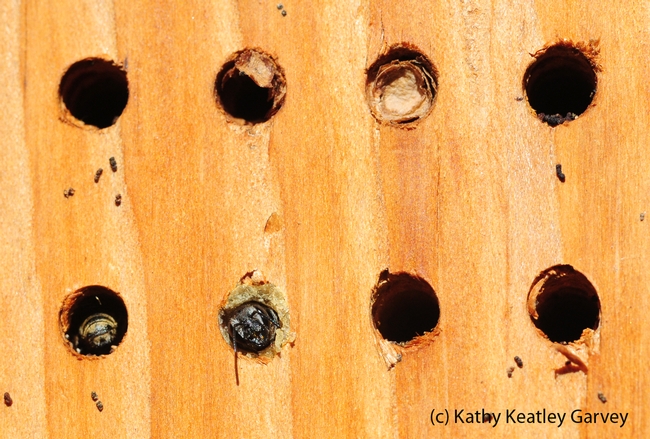All winter long my bee condo housed 16 tenants...and one earwig.
And quite comfortably, too, thank you.
It all began last fall when the leafcutting bees laid their eggs, provisioned each nest with a nectar/pollen ball, and plugged it with leaves.
Just about every morning, I did a bed check. Yes, 16 tenants and one earwig. (In actuality, there were probably more of those nasty little earwigs, but each time I checked, I found only one. But lots of frass!)
Bee condos are really just wood blocks drilled with tiny holes for native bee nests.
In late April and early May, the tenants began to stir. As of yesterday, 13 holes had popped open. Ah, emergence! The nocturnal earwig? Nowhere in sight.
You, too, can rear leafcutting bees (Megachile spp.) in your yard. All you need is the housing, which you can buy at most beekeeping supply stores or online. You can also go online and buy the plans to build them.
Senior conservation associate Matthew Shepherd of The Xerces Society for Invertebrate Conservation, in his fact sheet about native bee nesting sites, wrote: "There are 4,000 species of native bees in North America. Together they form the most important group of pollinators. Like all wildlife they are affected by changes in our landscapes, especially the loss of nesting sites. Bees make nests in which they create and provision brood cells for their offspring. In many modern landscapes, a desire for neatness has usually resulted in the removal of bare ground, dead trees, and untidy corners of rough grass—all important nesting sites for bees."
Native pollinator specialist Robbin Thorp, emeritus professor of entomology at the University of California, Davis, has provided a list of resources for native bee nesting requirements. It's available free on the Harry H. Laidlaw Jr. Honey Bee Research Facility website.
And, the Xerces Society recently published a Pollinator Conservation Handbook where you can find more information about our pollinators.
Just don't expect all your tenants to be pollinators, and all your pollinators to be tenants.
Attached Images:

